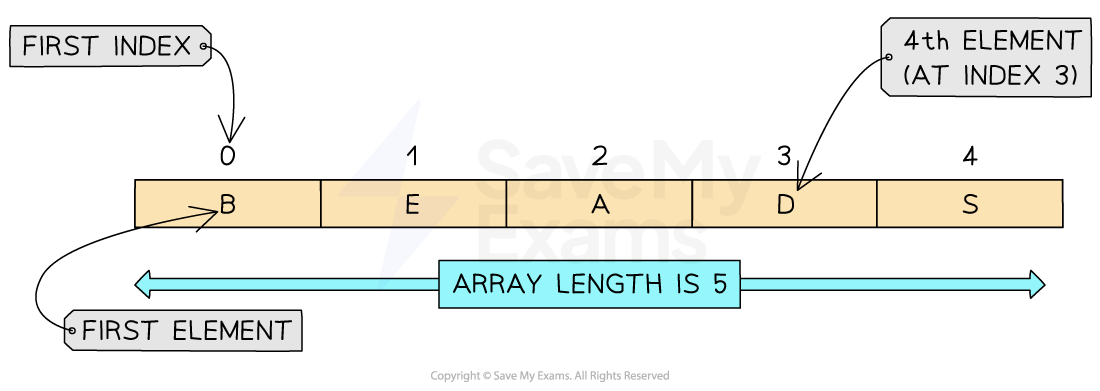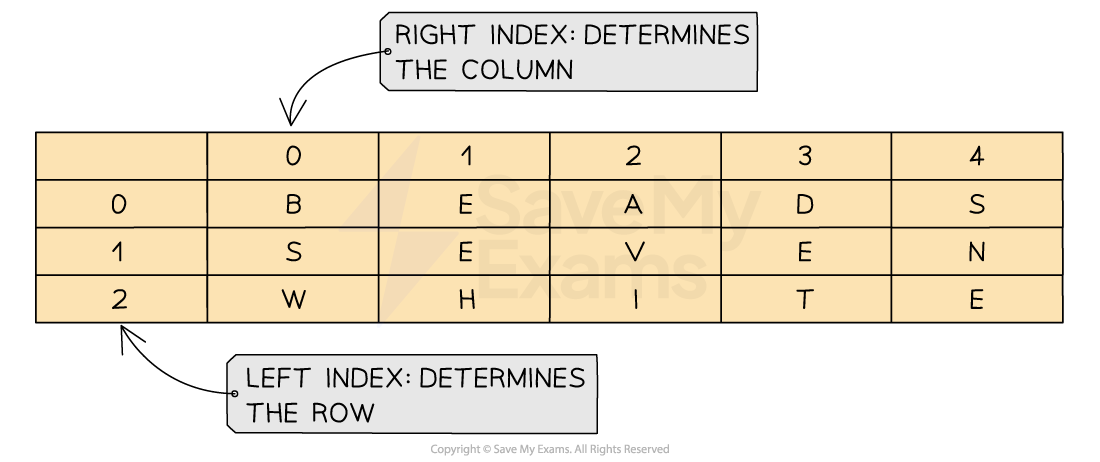Data Structures & Arrays (Edexcel GCSE Computer Science) : Revision Note
What is a data structure?
A data structure is a way of storing and organising data under one identifier so that it can be accessed and used efficiently
There are a wide range of data structures in Computer Science, however, the exam only requires knowledge of:
Strings
Arrays
Records
Strings
What is a string?
A string is a sequence of characters
Speech marks can often identify something as a string
Examples of strings include:
"Hello worlds"
"ABC"
"@#!%"
It is important to choose the correct data type for a given situation to ensure accuracy and efficiency in the program
Data types can be changed within a program, this is called casting
Records
What is a database?
A Database is an organised collection of data
It allows easy storage, retrieval, and management of information
A database is useful when working with large amounts of data, databases are stored on secondary storage
A database is often stored on remote servers so multiple users can access it at the same time, useful for online systems
Data can be sorted and searched efficiently, making use of more advanced structures
They are more secure than text files
A database uses fields and records to organise how it stores data
What are fields & records?
A field is one piece of information relating to one person, item or object
A field is represented in a database by a column,
A record is a collection of fields relating to one person, item or object
A record is represented in a database by a row
Text files
A text file is useful when working with small amounts of data, text files are stored on secondary storage and 'read' in to a program when being used
They are used to store information when the application is closed
Each entry is stored on a new line or separated with a special identifier, for example a comma (',')
It can be difficult in text files to know where a record begins and ends

Arrays
An array is useful when working with small amounts of data, arrays are stored in main memory (RAM)
They are used to store information when the application is in use
Can be more efficient and much faster to search than working with text files
1-Dimensional Arrays
What is an array?
An array is an ordered, static set of elements in a fixed-size memory location
An array can only store 1 data type
A 1D array is a linear array
Indexes start at 0, known as zero-indexed

Concept | Python |
Create |
|
Creates a blank array | |
| |
Creates an array called scores with values assigned | |
Assignment |
|
Assigns the colour "Red" to index 4 (5th element) |
Example in Python
Creating a one-dimensional array called ‘array’ which contains 5 integers.
Create the array with the following syntax:
array = [1, 2, 3, 4, 5]Access the individual elements of the array by using the following syntax:
array[index]Modify the individual elements by assigning new values to specific indexes using the following syntax:
array[index] = newValueUse the len function to determine the length of the array by using the following syntax:
len(array)In the example the array has been iterated through to output each element within the array. A for loop has been used for this
Python |
|---|
|
2-Dimensional Arrays
What is a 2-dimensional array?
A 2D array extends the concept on a 1D array by adding another dimension
A 2D array can be visualised as a table with rows and columns
When navigating through a 2D array you first have to go down the rows and then across the columns to find a position within the array

Concept | OCR exam reference | Python |
Create |
|
|
Creates a blank 2D array with 3 elements (0-2) | Creates a blank 2D array | |
|
| |
Creates a 2D array called players with values assigned | ||
Assignment |
|
|
Assigns the name "Holly" to index 0, 1 (1st row, 2nd column) - replaces "Paul" | ||
Example in Python
|
|
Examiner Tips and Tricks
In the exam, the question will always give an example to demonstrate which order the array is being read from.
Some questions can be X,Y and others can be Y, X. Always refer to the example before giving your answer!
Worked Example
A parent records the length of time being spent watching TV by 4 children
Data for one week (Monday to Friday) is stored in a 2D array with the identifier minsWatched.
The following table shows the array
| Quinn | Lyla | Harry | Elias | |
0 | 1 | 2 | 3 | ||
Monday | 0 | 34 | 67 | 89 | 78 |
Tuesday | 1 | 56 | 43 | 45 | 56 |
Wednesday | 2 | 122 | 23 | 34 | 45 |
Thursday | 3 | 13 | 109 | 23 | 90 |
Friday | 4 | 47 | 100 | 167 | 23 |
Write a line of code to output the number of minutes that Lyla watched TV on Tuesday [1]
Write a line of code to output the number of minutes that Harry watched TV on Friday [1]
Write a line of code to output the number of minutes that Quinn watched TV on Wednesday [1]
Answers
print(minsWatched[1,1]orprint(minsWatched[1][1]print(minsWatched[2,4]orprint(minsWatched[2][4]print(minsWatched[0,2]orprint(minsWatched[0][2]

You've read 0 of your 5 free revision notes this week
Unlock more, it's free!
Did this page help you?

